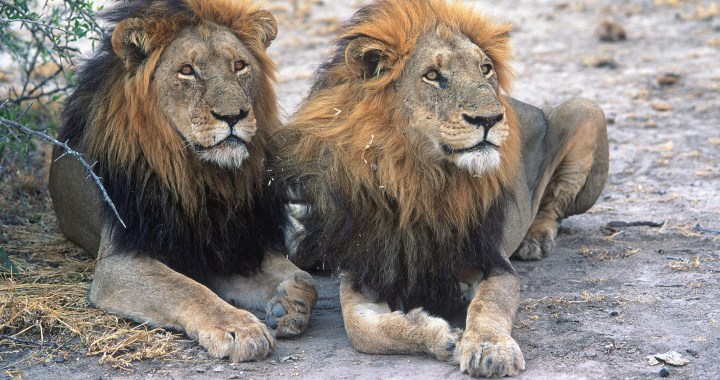ENVIRONMENTAL CRIME
Kruger lions being poisoned by poachers for body parts, says SANParks

South African National Parks has confirmed that lions have been targeted in a poisoning campaign in the northern Kruger Park by poachers seeking the animals’ body parts, presumably for the muti trade. The numbers are not huge, but in the wake of the rhino poaching onslaught, the targeting of another charismatic species in the iconic park will set off alarm bells among conservationists.
South African National Parks (SANParks) confirmed the poisonings in response to queries from Daily Maverick.
“For the period January 2020 up until the end of June 2023, a total of eight lions were found poisoned in the Xanatseni north region of the Kruger National Park. A further six lions were killed in snares over the same period,” SANParks said in an emailed response.
It said all the poisoning cases had been reported to the police and were being investigated by SANParks Environmental Crime Investigations Unit.
“Although the poisoning of lions is targeted, with various body parts of the animals removed, snaring remains indiscriminate and many different species are killed in snares,” SANParks said.
“In the last six months – January 2023 to June 2023 – a total of 1,987 snares have been removed on the Xanatseni north region which comprises the Pafuri, Punda Maria, Shingwedzi, Vlakteplaas, Shangoni and Woodlands sections,” it said.
This, it must be said, hardly compares with the wave of poaching that has seen thousands of rhinos killed for their horns in the Kruger over the past 15 years, decimating the population by up to 75% between 2011 and 2021.
The death of 14 lions – with eight known to have been targeted specifically for body parts, pointing to the trade in muti or traditional medicine, which highly prizes wild animal anatomy – over a period of three-and-half years is not a material threat to the park’s overall population of around 1,500 to 1,700 lions.
Shot across the bows
Still, when there is demand for such a product, criminal syndicates will find a way to poach and profit from it, so it is a warning shot across Kruger’s bows.
There is also a demand for lion bones in Asia, which South African captive-bred lions have been feeding.
Read more on Daily Maverick: Bones of contention – fate of thousands of captive lions in SA depends on the implementation of government report findings
That could potentially put wild cats in reserves with abundant populations in the cross-hairs in South Africa, which has well-established illegal trade routes to Asia for rhino horn and a host of other illegal stuff such as gold.
Just look at what the demand for rhino horn in Asia for a range of purposes – from medicinal to ornamental – has done to the pachyderm population. The tsunami of rhino poaching that has swept Kruger, an area the size of Israel that is difficult to secure and patrol, began as a ripple.
SANParks said it was being proactive about the situation.
“Considerable efforts are being made to monitor the lions in the far north of the park and SANParks is working closely with EWT (Endangered Wildlife Trust) to fit monitoring and tracking collars on the remaining prides,” it said.
“Field rangers also patrol areas which are known ‘hot spots’ for snaring, and routinely remove any snares which they locate. SANParks honorary rangers also conduct dedicated snare patrols in known hot-spot areas and make a significant contribution in removing snares, as well as recording relevant information for SANParks (types of snares such as wire or cable, GPS locations, age of snares etc).”
Translocations between the south of the park, which has a relatively robust population, and the north have also taken place. “The good performance of lions in southern Kruger is resulting in males and prides leaving the park looking for alternative territories. Often these move into areas where they could come into conflict with people,” SANParks said.
Human/wildlife conflict is simply not good for people or big critters.
“Proactively removing lions in the south that have left the park provides the opportunity to assist with the colonisation process in northern Kruger. This suggests that management can overcome disruptions caused by snaring and poisoning by introducing lions from southern Kruger while addressing the criminality of illegal harvesting of lions,” SANParks said.
“For this reason, SANParks introduced three prides and two males. A coalition of 12 males that naturally colonised, however, disrupted the newly introduced prides after about a year since the initiative started, resulting in several deaths.”
Complex dynamics
This highlights the complex ecological dynamics at play in a wildlife reserve that is subject to human management and interventions.
Hopefully, SANParks initiatives such as collaring and scrutiny of hot spots will nip this menace in the bud. The park hardly needs a new massacre of megafauna. But the social and economic context is challenging, to say the least.
Kruger is like an island of wildlife encircled by a growing sea of human poverty. The indiscriminate snaring points to trade in bushmeat, as well as perhaps muti, and anyone who ventures into the park to set snares probably doesn’t have a well-paying day job.
Having said that, some Kruger staff with regular salaries are also on the take – or vulnerable to the threats of criminal syndicates – enabling corruption to continue undermining the park’s capacity to confront poaching.
“For more than a decade, Kruger National Park has faced a relentless onslaught of rhino poaching. But today its greatest threat is internal corruption, itself a symptom of a breakdown in trust, staff cohesion and professionalism within the park,” researcher Julian Rademeyer notes in a report earlier this year, Landscapes of Fear, for the European Union-funded crime response organisation, Enact.
Read more in Daily Maverick: Kruger Park ensnared in corruption linked to criminal syndicates – report
Protecting wildlife in the Kruger, from lions to rhinos to impalas threatened by snares, is no walk in the park. DM
To read all about Daily Maverick’s recent The Gathering: Earth Edition, click here.






















 Become an Insider
Become an Insider
Time to copy the Botswana stance on patching! STK!!!
Which is what ?
We need to get the communities to benefit from tourism/conservation more from a financial and experiential point of the view. The problem is extremely complex.
If the communities around the park begin to truly benefit they will naturally begin to protect the park. It’s a long term project and the only way to make things sustainable.
I think all the rhino horn currently held by various groups around SA should be put into a bath of potassium cyanide or perhaps a neurotoxin, under very high pressure. Once the substance has deeply penetrated the horn and supersaturated it, the horn should be sold into the poaching black market. Once a few hundred people in the east die agonising deaths from cyanide or neurotoxin poisoning the demand for rhino horn will dry up over night. For other animals such as lions and vultures a systemic toxin could be developed that animals are immune to but which is toxic to human beings – the same as the tick poisons fed to dogs. The threatened animals could then be injected with this poison by darting them or by putting the substance into waterholes or feed blocks. When these revolting primitive savages – I hesitate to classify such barbarians as human – who kill animals for muthi consume or touch the body parts contaminated by the systemic toxic they will die. The demand for such animal body parts will vanish very rapidly once a few dozen of these savages die. Poachers and muthi makers deserve no sympathy, they are decimating a precious threatened heritage of ours, it is the animals that are endangered not the human beings, there are too many human beings anyway so if some die from poisoning after killing animals it is only right and just. Think of it all as evolution in action. The death penalty should be reintroduced for poaching, a life for a life.